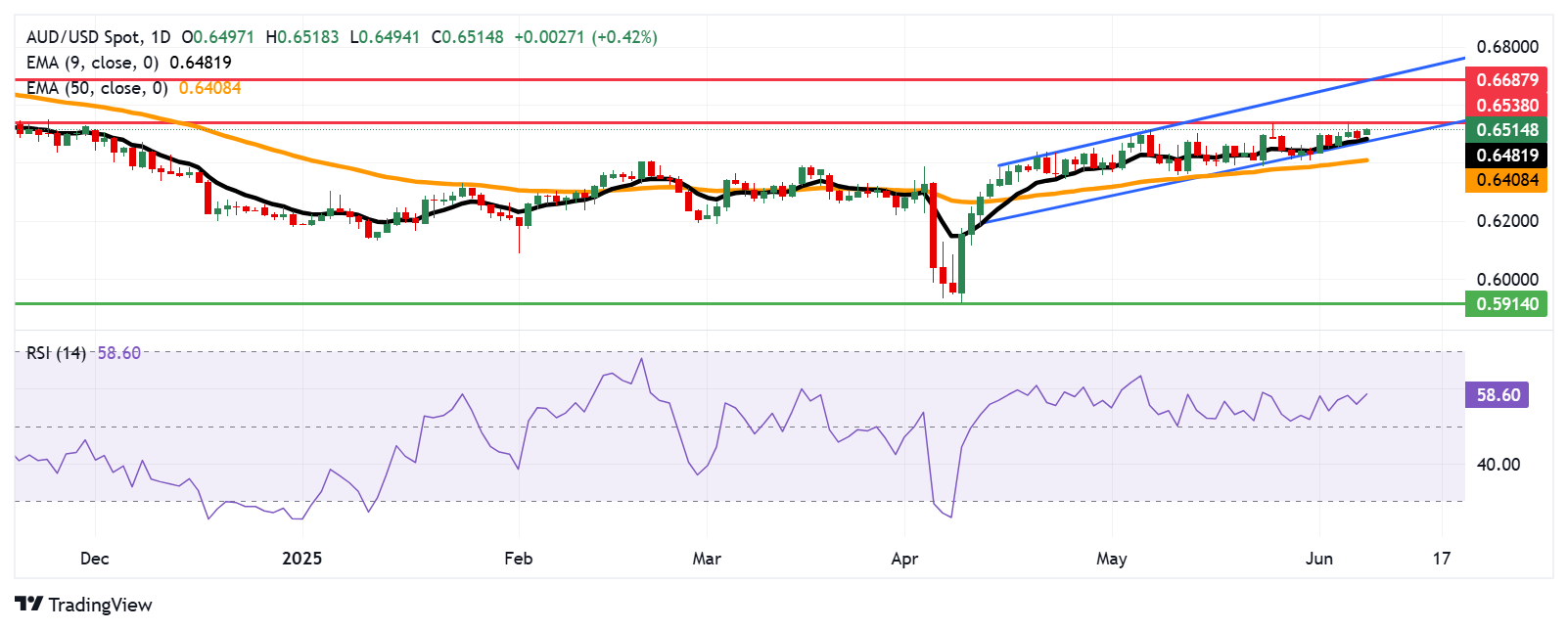- The Australian dollar maintains its position after mixed economic data from China published on Monday.
- The China consumer price index decreased 0.1% in May, compared to the expected fall of 0.2%.
- The US Treasury Secretary, Scott Besent, along with two other officials, will meet with Chinese officials later in the day.
The Australian dollar (AUD) rises against the US dollar on Monday, recovering its losses from the previous session. The Aud/USD pair remains strong after the publication of China’s key economic data.
The China National Statistics Office reported that the Consumer Price Index (CPI) fell at an annual rhythm of 0.1% in May, after the 0.1% drop in April. However, the market consensus expected a 0.2% decrease in the period reported. Meanwhile, China’s IP inflation decreased an intermensual 0.2%, compared to the 0.1% increase in April. China’s production price index (IPP) continues to weaken with an annual 3.3% drop in May, after a 2.7% decrease in April.
Traders will probably evaluate the renewed trade negotiations between the US and China, since President Donald Trump and Chinese President Xi Jinping agreed on Thursday that the officials of both parties would soon resume trade negotiations aimed at ending the commercial war. The US Treasury Secretary, Scott Besent, and two other Trump administration officials will meet with Chinese officials on Monday.
The subgovernor of the Bank of the Reserve of Australia (RBA), Sarah Hunter, warned that “the highest US tariffs will affect the global economy” and warned that greater uncertainty could reduce investment, production and employment in Australia.
The Australian dollar goes up while the US dollar corrects down
- The dollar index (DXY), which measures the value of the US dollar compared to six main currencies, is quote around 99.00 at the time of writing. However, the dollar received support from the US labor data stronger than expected for May, published on Friday.
- The US Labor Statistics Office (BLS) reported that the US non -agricultural payroll (NFP) increased by 139,000 in May compared to the increase of 147,000 (reviewed since 177,000) in April. This reading exceeded the market consensus of 130,000. In addition, the unemployment rate remained stable at 4.2%, and the average time gains were kept unchanged at 3.9%, both readings were stronger than expected by the market.
- The lightest US data than expected increased the chances of the Federal Reserve (FED) maintaining its reference interest rate without changes in its next two monetary policy meetings.
- The president of the USA, Donald Trump, requested, in a publication in Truth Social on Wednesday, the president of the Federal Reserve (Fed), Jerome Powell, to lower the policy rate. “Published N number! Too late! Powell must now lower the rate. It’s amazing! Europe has dropped nine times!” Trump said.
- On Wednesday, the president of the Fed of Minneapolis, Neel Kashkari, said the labor market shows some deceleration signs. However, constant uncertainty persists on the economy, and the Fed must remain in waiting mode to evaluate how the economy responds to uncertainty.
- The Chamber Republicans approved Trump’s “Great Project of Law”, a tax package and expenses of several billion dollars, which could increase the US fiscal deficit, together with the risk that the yields of the bonds remain high for longer. This scenario generates concerns about the US economy and leads traders to sell US assets under the tendency to “sell America.” Policy experts anticipate changes in the Senate while GOP legislators seek to finish the “great bill” for July 4.
- The Australia commercial balance registered a surplus of 5,413 million intermensual in April, below the 6,100 million expected and 6,892 million (reviewed from 6,900 million) in the previous reading. Exports fell an intermensual 2.4% in April, compared to an increase of 7.2% previous (reviewed from 7.6%). Meanwhile, imports increased 1.1%, compared to a 2.4%drop (reviewed from -2.2%) observed in March. The Caixin Services PMI of China rose to 51.1 in May as expected, from 50.7 in April.
- The Australian Statistics Office (ABS) showed that the Gross Domestic Product (GDP) grew by 0.2% intertrmetral in the first quarter, decreasing from the growth of the previous 0.6%. Australia’s economy did not reach the expected increase of 0.4%. Meanwhile, the annual GDP growth rate remained constant at 1.3%, below the 1.5% expected.
The Australian dollar advances above 0.6500 to seven months maximum
The AUD/USD is quoted around 0.6510 on Monday. The technical analysis of the daily chart indicates a persistent bullish bias, since the pair is maintained within the ascending channel pattern. In addition, the torque is maintained above the nine -day exponential (EMA) mobile average, indicating that the impulse of the short -term price is stronger. The 14 -day relative force index (RSI) is also positioned above the 50th brand, suggesting a bullish perspective.
The Aud/USD torque can find an immediate barrier in a maximum of seven months of 0.6538, reached on June 5. The rupture above this level could lead to the region around the upper limit of the upward channel around 0.6680, aligned with a maximum of eight months at 0.6687.
Down, the main support seems to be in the nine -day EMA of 0.6481, aligned with the lower limit of the upward channel around 0.6480. A rupture below this crucial support zone could weaken the bullish bias and take the aud/USD torque to test the 50 -day EMA at 0.6408.
AUD/USD: Daily graphic

Australian dollar Price today
The lower table shows the percentage of change of the Australian dollar (AUD) compared to the main currencies today. Australian dollar was the strongest currency against the US dollar.
| USD | EUR | GBP | JPY | CAD | Aud | NZD | CHF | |
|---|---|---|---|---|---|---|---|---|
| USD | -0.25% | -0.25% | -0.32% | -0.10% | -0.28% | -0.35% | -0.13% | |
| EUR | 0.25% | -0.02% | -0.10% | 0.13% | -0.01% | -0.12% | 0.10% | |
| GBP | 0.25% | 0.02% | 0.00% | 0.15% | 0.02% | -0.09% | 0.12% | |
| JPY | 0.32% | 0.10% | 0.00% | 0.23% | -0.00% | -0.08% | 0.08% | |
| CAD | 0.10% | -0.13% | -0.15% | -0.23% | -0.20% | -0.25% | -0.04% | |
| Aud | 0.28% | 0.01% | -0.02% | 0.00% | 0.20% | -0.10% | 0.11% | |
| NZD | 0.35% | 0.12% | 0.09% | 0.08% | 0.25% | 0.10% | 0.21% | |
| CHF | 0.13% | -0.10% | -0.12% | -0.08% | 0.04% | -0.11% | -0.21% |
The heat map shows the percentage changes of the main currencies. The base currency is selected from the left column, while the contribution currency is selected in the upper row. For example, if you choose the Australian dollar of the left column and move along the horizontal line to the US dollar, the percentage change shown in the box will represent the Aud (base)/USD (quotation).
Faqs Australian dollar
One of the most important factors for the Australian dollar (Aud) is the level of interest rates set by the Australian Reserve Bank (RBA). Since Australia is a country rich in resources, another key factor is the price of its greatest export, iron mineral. The health of the Chinese economy, its largest trading partner, is a factor, as well as inflation in Australia, its growth rate and commercial balance. The feeling of the market, that is, if investors are committed to more risky assets (Risk-on) or seek safe shelters (Risk-Off), it is also a factor, being the positive risk-on for the AUD.
The Australian Reserve Bank (RBA) influences the Australian dollar (AUD) by setting the level of interest rates that Australian banks can lend to each other. This influences the level of the interest rates of the economy as a whole. The main objective of the RBA is to maintain a stable inflation rate of 2% -3% by adjusting the interest rates or the low. Relatively high interest rates compared to other large central banks support the AU, and the opposite for the relatively low. The RBA can also use relaxation and quantitative hardening to influence credit conditions, being the first refusal for the AU and the second positive for the AUD.
China is Australia’s largest commercial partner, so the health of the Chinese economy greatly influences the value of the Australian dollar (Aud). When the Chinese economy goes well, it buys more raw materials, goods and services in Australia, which increases the demand of the AU and makes its value upload. The opposite occurs when the Chinese economy does not grow as fast as expected. Therefore, positive or negative surprises in Chinese growth data usually have a direct impact on the Australian dollar.
Iron mineral is the largest export in Australia, with 118,000 million dollars a year according to data from 2021, China being its main destination. The price of iron ore, therefore, can be a driver of the Australian dollar. Usually, if the price of iron ore rises, the Aud also does, since the aggregate demand of the currency increases. The opposite occurs when the price of low iron ore. The highest prices of the iron mineral also tend to lead to a greater probability of a positive commercial balance for Australia, which is also positive for the AUD.
The commercial balance, which is the difference between what a country earns with its exports and what it pays for its imports, is another factor that can influence the value of the Australian dollar. If Australia produces highly requested exports, its currency will gain value exclusively for the excess demand created by foreign buyers who wish to acquire their exports to what you spend on buying imports. Therefore, a positive net trade balance strengthens the AUD, with the opposite effect if the commercial balance is negative.
Source: Fx Street
I am Joshua Winder, a senior-level journalist and editor at World Stock Market. I specialize in covering news related to the stock market and economic trends. With more than 8 years of experience in this field, I have become an expert in financial reporting.





